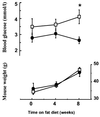11beta-hydroxysteroid dehydrogenase type 1 knockout mice show attenuated glucocorticoid-inducible responses and resist hyperglycemia on obesity or stress
- PMID: 9405715
- PMCID: PMC25139
- DOI: 10.1073/pnas.94.26.14924
11beta-hydroxysteroid dehydrogenase type 1 knockout mice show attenuated glucocorticoid-inducible responses and resist hyperglycemia on obesity or stress
Abstract
Glucocorticoid hormones, acting via nuclear receptors, regulate many metabolic processes, including hepatic gluconeogenesis. It recently has been recognized that intracellular glucocorticoid concentrations are determined not only by plasma hormone levels, but also by intracellular 11beta-hydroxysteroid dehydrogenases (11beta-HSDs), which interconvert active corticosterone (cortisol in humans) and inert 11-dehydrocorticosterone (cortisone in humans). 11beta-HSD type 2, a dehydrogenase, thus excludes glucocorticoids from otherwise nonselective mineralocorticoid receptors in the kidney. Recent data suggest the type 1 isozyme (11beta-HSD-1) may function as an 11beta-reductase, regenerating active glucocorticoids from circulating inert 11-keto forms in specific tissues, notably the liver. To examine the importance of this enzyme isoform in vivo, mice were produced with targeted disruption of the 11beta-HSD-1 gene. These mice were unable to convert inert 11-dehydrocorticosterone to corticosterone in vivo. Despite compensatory adrenal hyperplasia and increased adrenal secretion of corticosterone, on starvation homozygous mutants had attenuated activation of the key hepatic gluconeogenic enzymes glucose-6-phosphatase and phosphoenolpyruvate carboxykinase, presumably, because of relative intrahepatic glucocorticoid deficiency. The 11beta-HSD-1 -/- mice were found to resist hyperglycamia provoked by obesity or stress. Attenuation of hepatic 11beta-HSD-1 may provide a novel approach to the regulation of gluconeogenesis.
Figures




References
-
- Miller W L, Tyrrell J B. In: Endocrinology and Metabolism. 3rd Ed. Felig P, Baxter J D, Frohman L, editors. New York: McGraw Hill; 1995. pp. 555–711.
-
- Albiston A L, Obeyesekere V R, Smith R E, Krozowski Z S. Mol Cell Endocrinol. 1994;105:R11–R17. - PubMed
-
- Edwards C R W, Stewart P M, Burt D, Brett L, McIntyre M A, Sutanto W S, de Kloet E R, Monder C. Lancet. 1988;2:986–989. - PubMed
Publication types
MeSH terms
Substances
Grants and funding
LinkOut - more resources
Full Text Sources
Other Literature Sources
Medical
Molecular Biology Databases

